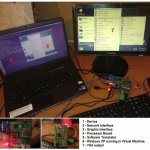
A general method to design and implement a thin client for VNC (Virtual Network Computing) is presented. In order to connect the device to network and monitor, a 16-bit network interface called WIZ830MJ is applied. Moreover, a solution to design 24-bit graphic interface, using the SSD1963 chip and a DAC (Digital-to-Analog Converter) known as ADV7125, is introduced which provide users with a resolution up to 800X480 pixels. To enhance the efficiency of the device, the translator software is designed between VNC server and client which allows applying FastLZ compression Algorithm. By modifying the RFB (Remote Frame Buffer) protocol, the designed translator avoids some problems such as “TCP Window Full” and “TCP Retransmission” and reduces the network bandwidth consumption. The device has no need to fast processor and operating system. It has a good performance using an ARM Cortex-M4 processor with working frequency of 100 MHz. This issue is important because VNC software needs an operating system like LINUX, which itself requires a more robust processor and more consumed energy than an embedded device. At the end of the present paper, the designed device is tested in a laboratory and the results are presented.
For more detail, go to http://www.jatit.org/volumes/Vol83No2/14Vol83No2.pdf


COMMENTS